Know Everything About Hindus Biggest Festival Dussehra Celebration 2024
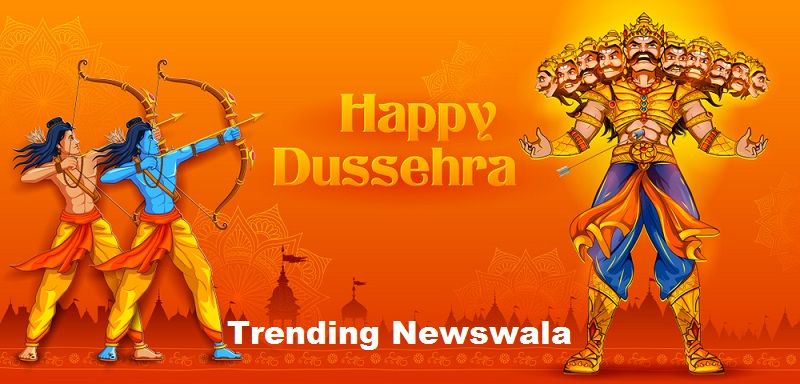
Dussehra, also known as Vijayadashami, stands tall as one of Hinduism's most significant festivals. Rooted in mythology and celebrated with zeal, this festival marks the victory of good over evil. As we approach Dussehra in 2024, anticipation is high for a grand celebration that promises to immerse communities in spiritual fervor and cultural splendor.
The essence of Dussehra lies in its mythological origins, with various narratives contributing to its significance. Predominantly, it commemorates the victory of Lord Rama over the demon king Ravana. The epic Ramayana narrates the tale of Lord Rama's triumph, symbolizing the ultimate conquest of righteousness over malevolence.
Ramlila Extravaganza

Ramlila is a traditional performance art form that reenacts the life and adventures of Lord Rama, a central figure in Hindu mythology. The term "Ramlila" is derived from two words: "Rama," the protagonist of the Ramayana, and "Lila," which means play or drama. Ramlila is a dramatic representation of the events described in the Ramayana, and it is particularly popular during The festival of Dussehra.
Origin and History: The tradition of Ramlila dates back several centuries. Its roots can be traced to the devotional performances that were organized by saints and poets to narrate the stories from the Ramayana. Over time, these performances evolved into the elaborate and theatrical Ramlila that we witness today.
Duration: Ramlila is generally performed over a period of ten days, leading up to the grand finale on the day of Dussehra. Each day corresponds to a specific episode or incident from the Ramayana, allowing for a comprehensive retelling of Lord Rama's life.
Open-air Performances: Ramlila is typically staged in open-air arenas, such as makeshift stages or grounds in various localities. The choice of an open setting allows for a larger audience to gather and witness the performances.
Characters and Costumes: The Ramlila cast includes actors who portray key characters from the Ramayana, such as Lord Rama, Sita, Lakshmana, Hanuman, and the antagonist Ravana. The actors wear elaborate costumes and makeup to closely resemble the characters they represent.
Script and Dialogues: The script of Ramlila is based on the Ramayana, and the dialogues are often delivered in the form of poetic verses or shlokas. The language used is typically a mix of classical and colloquial, adding a poetic and rhythmic quality to the performances.
Music and Dance: Music and dance play an integral role in Ramlila. Traditional instruments like the tabla, dholak, and flute are commonly used to create a vibrant and melodious atmosphere. In addition to dialogues, there are often choreographed dance sequences that enhance the visual appeal of the performances.
Devotional Atmosphere: Ramlila is not just a theatrical performance; it is a devotional and cultural event. The audience, often consisting of families and community members, participates with reverence, engaging in prayer and rituals as part of the overall experience.
Culmination on Dussehra: The Ramlila performances reach their climax on the day of Dussehra, marking the ultimate victory of Lord Rama over Ravana. The grand finale often includes the burning of effigies of Ravana, symbolizing the triumph of good over evil.
Ramlila is not only a source of entertainment but also a powerful medium for transmitting cultural and moral values. It brings communities together, fostering a sense of unity and devotion as people collectively celebrate the timeless virtues exemplified in the epic tale of the Ramayana.
Dussehra celebrations are synonymous with the enactment of Ramlila, a series of plays depicting the life of Lord Rama. Across the country, open-air stages come alive with vibrant performances, engaging audiences in the age-old saga of virtue prevailing over vice.
Durga Puja Spectacle
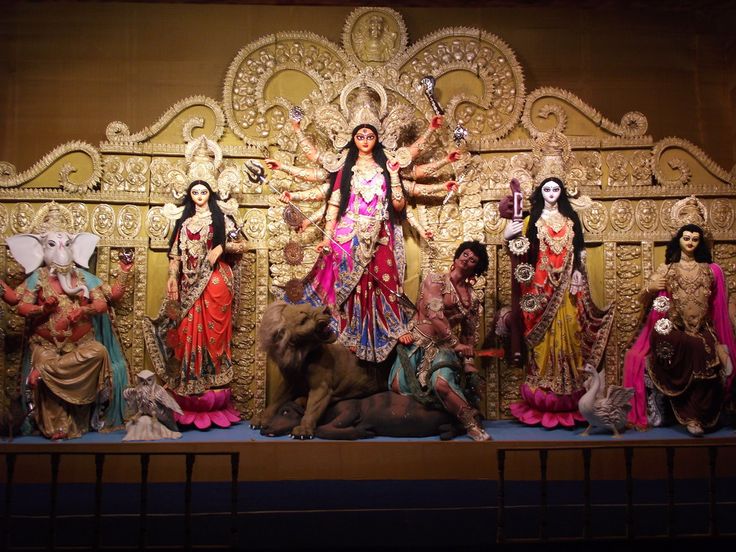
Durga Puja is a major Hindu festival dedicated to the goddess Durga, who is revered as a symbol of divine feminine power and strength. The festival culminates with a grand spectacle that includes elaborate decorations, artistic representations of the goddess, and vibrant processions. Here are more details about the Durga Puja spectacle:
Festival Duration: Durga Puja is a multi-day festival, typically spanning over nine nights and ten days. It usually falls in the Hindu calendar month of Ashwin, which corresponds to September or October in the Gregorian calendar.
Pandals and Decorations: One of the most striking features of Durga Puja is the construction of temporary structures called pandals, which serve as the ceremonial platforms for the goddess. These pandals are often intricately designed and decorated, showcasing a variety of themes, artistic styles, and craftsmanship.
Artistic Representations of Goddess Durga: The centerpiece of Durga Puja is the artistic representation of Goddess Durga. Highly skilled artisans create magnificent idols of the goddess, typically depicting her with ten arms, each holding a weapon, and riding a lion. The idols are adorned with elaborate jewelry and vibrant clothing, capturing the divine essence of the goddess.
Idol Immersion Procession: The festival concludes with the immersion of the Durga idols in rivers or water bodies. The procession accompanying the idols is a grand affair, with devotees and onlookers participating in the farewell ceremony. Traditional music, dance, and cultural performances often accompany the procession, creating a festive and celebratory atmosphere.
Dhunuchi Dance and Aarti: During Durga Puja, devotees engage in traditional dances known as Dhunuchi dance. This involves dancing with a traditional earthen pot (dhunuchi) containing burning incense or coconut husk, creating a mesmerizing visual and aromatic experience. Aarti (devotional songs) are also performed, adding a spiritual dimension to the celebrations.
Community Participation: Durga Puja is a community-driven festival, and the organizing committees involve local residents in various aspects of the celebrations. Communities come together to contribute time, resources, and creativity to make the festival a memorable event for everyone.
Cultural Programs and Competitions: Many Durga Puja committees organize cultural programs, competitions, and events during the festival. These may include traditional and contemporary dance performances, music concerts, art exhibitions, and literary events, adding an intellectual and artistic layer to the celebrations.
Feasting and Prasad Distribution: Durga Puja is also a time for feasting and sharing meals with family and friends. Devotees prepare special dishes as an offering to the goddess, and the prasad (blessed food) is distributed among the community members.
Durga Puja is not just a religious observance; it is a cultural extravaganza that brings communities together in a spirit of joy, creativity, and devotion. The elaborate decorations, artistic representations, and grand processions make it a unique and visually stunning spectacle that showcases the rich cultural heritage of India
In various regions, Dussehra aligns with the culmination of Durga Puja. Elaborate pandals adorned with artistic depictions of Goddess Durga and her entourage become focal points for devotees and art enthusiasts alike. The festival concludes with the immersion of Durga idols, marking the goddess's return to her celestial abode.
Effigy Burning Processions:
- A hallmark of Dussehra celebrations is the grand procession featuring effigies of Ravana, Meghnad, and Kumbhakarna. The effigies are paraded through the streets amid music, dance, and exuberant crowds. The festivities culminate with the symbolic burning of these effigies, symbolizing the eradication of evil forces.
Agricultural Festivities:
- Dussehra's connection to the harvest season is celebrated in regions where it coincides with agricultural milestones. Farmers express gratitude for the abundance of the harvest and seek blessings for future prosperity. This agricultural aspect adds a unique layer to the festival, underscoring the cyclical nature of life.
Family Bonding and Festive Feasts:
- Dussehra is a time for families and friends to come together. Exchanging sweets, gifts, and good wishes strengthens the sense of community and unity. Festive feasts, often featuring traditional dishes, further enhance the joyous atmosphere.
Spiritual Significance: Beyond the vibrant festivities, Dussehra carries profound spiritual meaning. It serves as a powerful reminder that, irrespective of life's challenges, goodness will always prevail. The festival encourages individuals to reflect on the eternal battle between right and wrong, inspiring them to uphold righteousness in their lives.
As Dussehra 2024 approaches, the excitement and anticipation are palpable. This festival, steeped in tradition and spirituality, brings communities together in a celebration of shared heritage. Whether it's the captivating Ramlila performances, the majestic Durga Puja processions, or the symbolic burning of effigies, Dussehra is a time to rejoice in the enduring triumph of virtue over vice. Let the vibrant colors, cultural richness, and spiritual significance of Dussehra 2024 unite us all in a celebration that transcends borders and embraces the divine essence within.
The Ravana Ten Heads
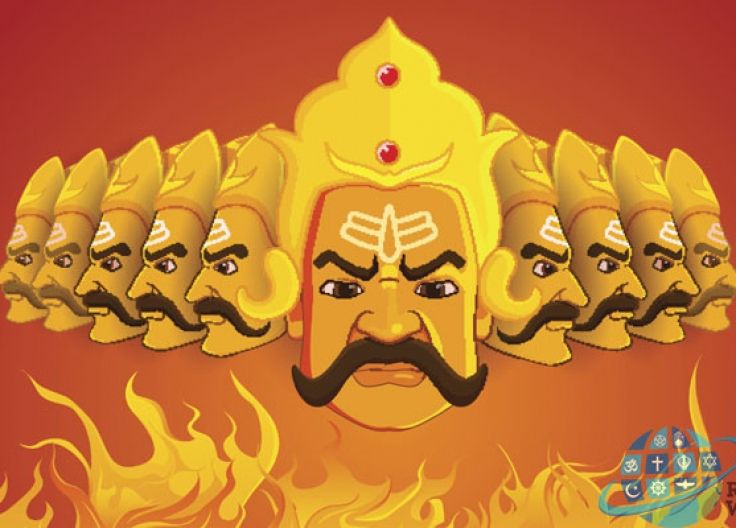
The depiction of Ravana with ten heads is a significant aspect of Hindu mythology, particularly in the epic Ramayana. Ravana, the antagonist in the Ramayana, is a powerful and learned demon king who rules the kingdom of Lanka. The ten heads are a distinctive feature of his character, and each head holds symbolic meaning. Here are more details about the symbolism and significance of Ravana's ten heads:
Symbolism of the Ten Heads: The ten heads of Ravana are symbolic of his immense knowledge and wisdom. According to Hindu mythology, Ravana was not just a warrior but also a highly knowledgeable scholar and practitioner of the arts. Each head represents a facet of his intellectual prowess, making him a formidable adversary for Lord Rama.
Intellectual Brilliance: The ten heads of Ravana are said to symbolize his mastery over the ten principal directions, indicating his extensive knowledge and control over various domains. Ravana was a master of scriptures, arts, music, and warfare, showcasing a well-rounded intellectual brilliance.
Mastery Over Time: In some interpretations, the ten heads are also associated with Ravana's control over the past, present, and future. This emphasizes his perceived invincibility and dominance over the fabric of time.
Symbol of Ego: Another interpretation suggests that Ravana's ten heads represent his tenfold ego. His arrogance and pride in his own abilities and achievements were considered excessive, leading to his downfall. The ten heads symbolize the multiplicity of his egoistic nature.
Comparison with Dashavatara: The ten heads of Ravana are sometimes compared to the ten avatars (incarnations) of Lord Vishnu, known as the Dashavatara. This comparison highlights the contrast between the divine purpose of Vishnu's avatars, which aim to restore cosmic order, and Ravana's misuse of his intellectual gifts for selfish and malevolent purposes.
Devotion to Shiva: Ravana was a devoted follower of Lord Shiva, and his ten heads are also associated with the tenets of Shaivism. It is believed that Ravana gained immense powers through penance and devotion to Shiva, and the ten heads may symbolize his alignment with the principles of Shaiva philosophy.
Artistic Representations: In artistic representations, Ravana is often portrayed with ten heads arranged in a towering crown-like structure. Each head may have distinct facial expressions, emphasizing the diversity of his intellectual capabilities.
Destruction of Ego: The ultimate defeat of Ravana by Lord Rama in the Ramayana is seen as the triumph of righteousness over ego and arrogance. The ten heads are a reminder that even the most intellectually gifted beings are not immune to the consequences of misuse of power and hubris.
In summary, the ten heads of Ravana in Hindu mythology serve as a powerful symbol of intellectual prowess, but also as a cautionary tale about the dangers of unchecked ego and the importance of aligning knowledge with righteousness. The story of Ravana and his ten heads continues to be a rich source of moral and philosophical lessons in Hindu culture.
Ravana is depicted as the king of rakshasass. Lord Rama had to destroy each of the heads to defeat Ravana. These ten head depict the 10 Evil traits lust, Anger, Ego, Pride, Selfishness, Jealousy, Injustice, Greed and lack of humanity.
Worship of Goddess Durga
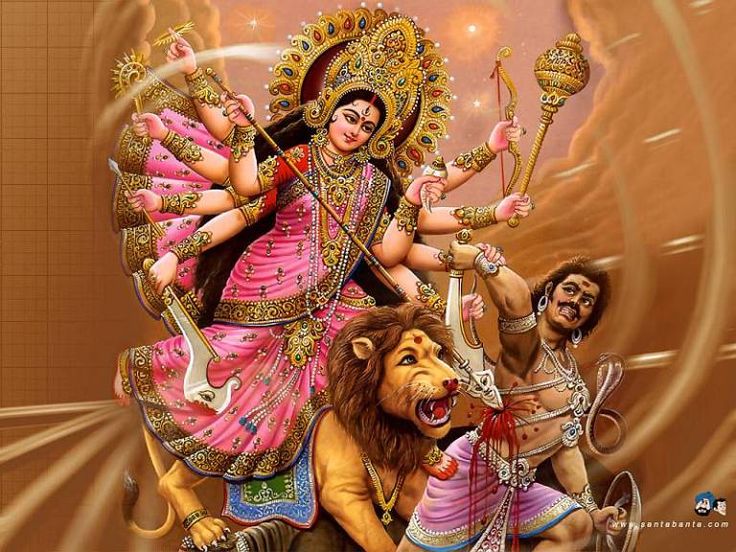
The worship of Goddess Durga, known as Durga Puja, is one of the most prominent and widely celebrated festivals in Hinduism. It typically takes place over a ten-day period, culminating in the grand finale on the day of Vijayadashami or Dussehra. Here are more details about the worship of Goddess Durga:
Festival Duration: Durga Puja spans nine nights and ten days, known as Navaratri. It usually falls in the Hindu calendar month of Ashwin, which corresponds to September or October in the Gregorian calendar.
Symbolism of Goddess Durga: Goddess Durga is revered as a divine embodiment of Shakti, the primordial cosmic energy that represents the feminine aspect of the divine. She is often depicted riding a lion, wielding various weapons in her multiple arms, symbolizing her power to protect and uphold righteousness.
Creation of the Idol: The worship of Durga involves the creation of intricate and artistically crafted idols of the goddess. Skilled artisans create these idols from clay, depicting Durga with ten arms, each holding a different weapon, and trampling upon the demon Mahishasura, symbolizing the triumph of good over evil.
Installation of the Idol: The idols of Goddess Durga are installed in temporary structures called pandals, which serve as ceremonial platforms. These pandals are often adorned with elaborate decorations, themes, and artistic elements, creating a visually stunning and spiritually charged environment.
Prana Pratishtha (Consecration): Before the festival begins, a ceremony known as Prana Pratishtha is performed to infuse life or divine energy into the idol. This involves a series of rituals and prayers conducted by priests to invoke the presence of the goddess.
Devotional Rituals: Durga Puja involves a series of devotional rituals, including daily prayers, recitation of hymns, and offerings of flowers, fruits, and sweets to the goddess. Devotees express their reverence through these rituals, seeking the blessings of Goddess Durga for strength, protection, and well-being.
Aarti and Dhunuchi Dance: Devotees perform Aarti, a ritual of waving lighted lamps before the goddess, accompanied by the singing of devotional songs. Dhunuchi dance, involving traditional dance movements with a smoking earthen pot (dhunuchi) containing burning incense, is also a common feature during the festivities.
Navaratri Celebrations: The nine nights of Navaratri are dedicated to the worship of different forms of the goddess. Each night, a specific aspect of Durga, known as Navadurga, is venerated. Devotees observe fasts, participate in cultural events, and engage in prayer and meditation during this period.
Cultural Programs and Events: Durga Puja is not just a religious observance; it is a cultural extravaganza. Many pandals organize cultural programs, including traditional and contemporary dance performances, music concerts, art exhibitions, and literary events, adding a festive and intellectual dimension to the celebrations.
Idol Immersion Procession: The festival concludes with the immersion of the Durga idols in rivers or water bodies. The immersion procession, known as Visarjan, is a grand affair with devotees bidding farewell to the goddess through music, dance, and traditional rituals.
Durga Puja is not only a religious ritual but also a social and cultural celebration that unites communities and showcases the rich tapestry of Hindu traditions. The worship of Goddess Durga symbolizes the triumph of good over evil, the power of divine femininity, and the importance of righteousness in the face of adversity
Along with the Goddess Durga, the Goddess Laksmi Saraswati are also worshipped in Bengal. The Bengali also worshiped Lord Ganesha Kartik on a daily basis. This is exactly why all these five idols are seen together in Durga puja. Vijayadashami the victory of Goddess Durga over the demon Mahishasura. the king of demons who was very powerful during this period and tortured innocent people. on the tenth day of the lunar calendar.
Significance of Navratri
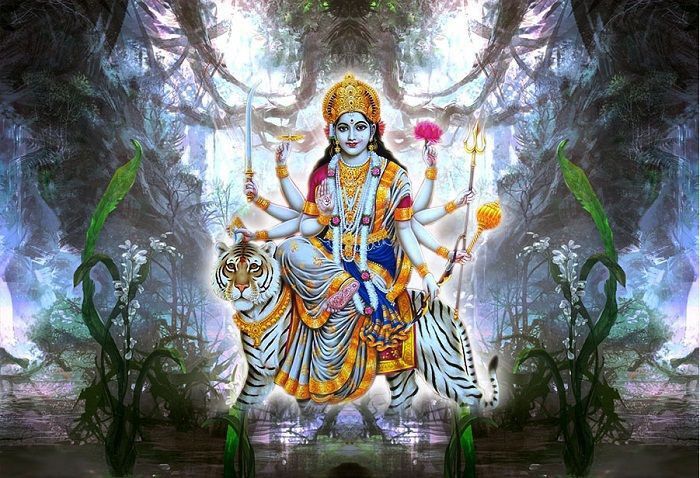
Navratri, also spelled as Navaratri, is a Hindu festival celebrated over nine nights and ten days, dedicated to the worship of the divine feminine in various forms. The festival holds immense significance in Hinduism and is observed twice a year – once in the spring (Chaitra Navratri) and once in the autumn (Sharad Navratri). Here are more details about the significance of Navratri:
Goddess Durga's Victory: Navratri marks the celebration of the triumph of Goddess Durga over the buffalo demon Mahishasura. The festival is a symbolic representation of the victory of good over evil, light over darkness, and the divine over demonic forces.
Navadurga Forms: Each day of Navratri is dedicated to the worship of a specific form of Goddess Durga, collectively known as Navadurga. These forms include Shailaputri, Brahmacharini, Chandraghanta, Kushmanda, Skandamata, Katyayani, Kalaratri, Mahagauri, and Siddhidatri. Devotees offer prayers, perform rituals, and recite hymns dedicated to each form during the nine nights.
Navratri Colors: Each day of Navratri is associated with a specific color, and devotees traditionally wear clothes of that color during the corresponding day. The colors are believed to represent the various aspects of the goddess and are chosen based on their significance in Hindu mythology and cultural traditions.
Fasting and Penance: Many devotees observe fasts during Navratri, abstaining from certain foods and maintaining a pious lifestyle. Fasting is considered a form of penance and self-discipline, symbolizing devotion and surrender to the divine.
Cultural Celebrations: Navratri is not just a religious festival; it is also a time for cultural celebrations. Traditional dance forms like Garba and Dandiya are popular during Navratri, especially in the western states of Gujarat and Rajasthan. These dances symbolize the joyous celebration of life and devotion to the divine.
Worship of Shakti: Navratri is dedicated to the worship of Shakti, the divine feminine energy that permeates the universe. Devotees seek the blessings of Goddess Durga to attain strength, wisdom, and protection.
Durga Puja Culmination: Navratri concludes with the festival of Dussehra or Vijayadashami, which celebrates the victory of Lord Rama over the demon king Ravana. Effigies of Ravana are burned in large public events, symbolizing the destruction of evil forces.
Renewal and Spiritual Cleansing: Navratri is considered a time of spiritual purification and renewal. Devotees engage in prayer, meditation, and self-reflection to cleanse themselves of impurities and strengthen their spiritual connection.
Fertility and Harvest Festival: In some regions, Navratri is associated with fertility and agricultural prosperity. The festival coincides with the harvest season, and prayers are offered for a bountiful harvest and agricultural abundance.
Community Bonding: Navratri brings communities together as families and friends participate in religious rituals, cultural events, and dance celebrations. It fosters a sense of unity, shared values, and collective devotion.
In essence, Navratri is a multifaceted festival that encompasses religious, cultural, and social dimensions. It signifies the eternal victory of good over evil, the power of the divine feminine, and the importance of spiritual discipline and devotion in one's life. The festival's colorful and joyous celebrations resonate with people across India and beyond.
This is the reason why Dussehra is celebrated on the tenth day after worshiping Durga Maa for nine days in the Sharadiya Navratras. Apart from this, there is another religious legend associated with it that the mahasangram of Maa Durga and Mahishasura Raksha was run for nine days. On the tenth day, Maa Durga killed Mahishasura and since then the festival started.
Why do we burn Ravan on Dussehra
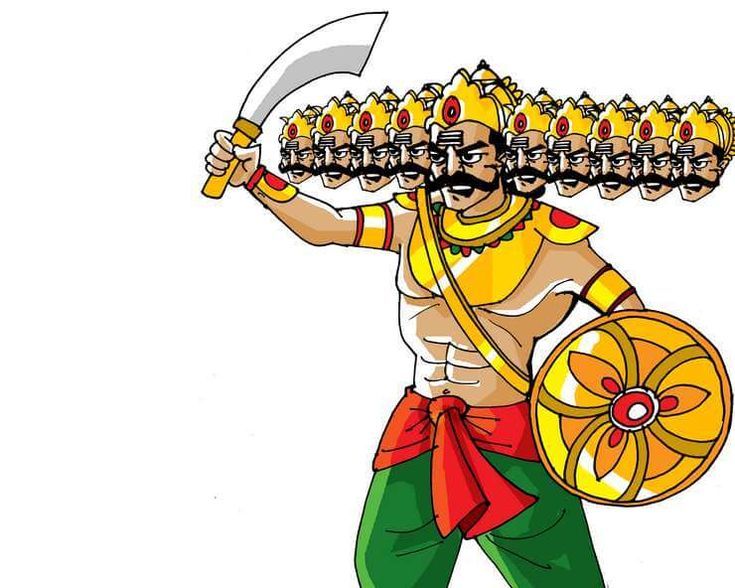
The tradition of burning effigies of Ravana, along with his son Meghanada (also known as Kumbhakarna) and brother Kumbhakarna, on the festival of Dussehra holds deep symbolic and mythological significance. Here are more details about why effigies of Ravana are burned on Dussehra:
Victory of Good over Evil: The primary significance of burning effigies of Ravana is to symbolize the victory of good (represented by Lord Rama) over evil (symbolized by Ravana). According to the Hindu epic Ramayana, Lord Rama waged a war against Ravana to rescue his wife Sita, who had been abducted by the demon king. The burning of Ravana's effigy signifies the triumph of righteousness and the defeat of malevolence.
Ramayana Narrative: The burning of Ravana effigies is closely linked to the climax of the Ramayana. Lord Rama, with the help of his loyal companion Hanuman and his army, defeats Ravana in a ten-day battle. The war culminates on the day of Vijayadashami, which is celebrated as Dussehra.
Symbolic Destruction of Ego: Ravana is often seen as a complex character who possessed great knowledge and power but succumbed to arrogance and ego. The burning of his effigy symbolizes the destruction of these negative qualities, emphasizing the importance of humility and righteousness.
Demonstration of Righteous Fury: The burning of Ravana's effigy is also a symbolic act of expressing righteous anger and fury against those who oppose dharma (righteousness) and engage in wrongful actions. It serves as a reminder that evil actions will eventually face consequences.
Purification and Renewal: The act of burning Ravana's effigy is considered a form of purification and renewal. It signifies the removal of negativity, impurities, and obstacles from one's life. People participate in the burning ritual to seek the blessings of the divine for a fresh start and the triumph of good over personal challenges.
Festive Culmination: Dussehra marks the end of the Navratri festival, which is dedicated to the worship of Goddess Durga. The burning of Ravana's effigy is the final act of celebration, symbolizing the successful conclusion of the festival and the victory of the divine over demonic forces.
Cultural Tradition: The tradition of burning Ravana effigies has been passed down through generations and has become an integral part of Dussehra celebrations in various parts of India. It is a cultural ritual that unites communities and serves as a theatrical representation of the age-old mythological narrative.
Public Festivities: The burning of Ravana effigies is often accompanied by large public gatherings, processions, and cultural events. Communities come together to witness the spectacle, reinforcing a sense of shared identity and joyous celebration.
In summary, the burning of Ravana effigies on Dussehra symbolizes the triumph of good over evil, the destruction of ego and arrogance, and the purification of oneself and society. It is a powerful and visually dramatic expression of the enduring values embedded in Hindu mythology and culture.
Ravan observed all this and disguised himself as a holy sage. He approached Sita asking for food. Sita offered him food, standing within the Lakshman Rekha. But, Ravan angrily denied to accept it and told her to come out of that line. As soon as Sita crossed the Lakshman Rekha, Ravan caught her hand and took her away from Lord Ram, towards Lanka ( at present Sri Lanka ), in his magical chariot. All attempt of Sita to save herself was all in vain. To bring back Sita, Lord Ram, led a battle against Ravan with the help of Hanuman and their monkey-army, and at last, we're able to defeat Ravan. To celebrate this victory of good every year we burn Ravan, the symbol of evil.
Why is Navratri Celebrated
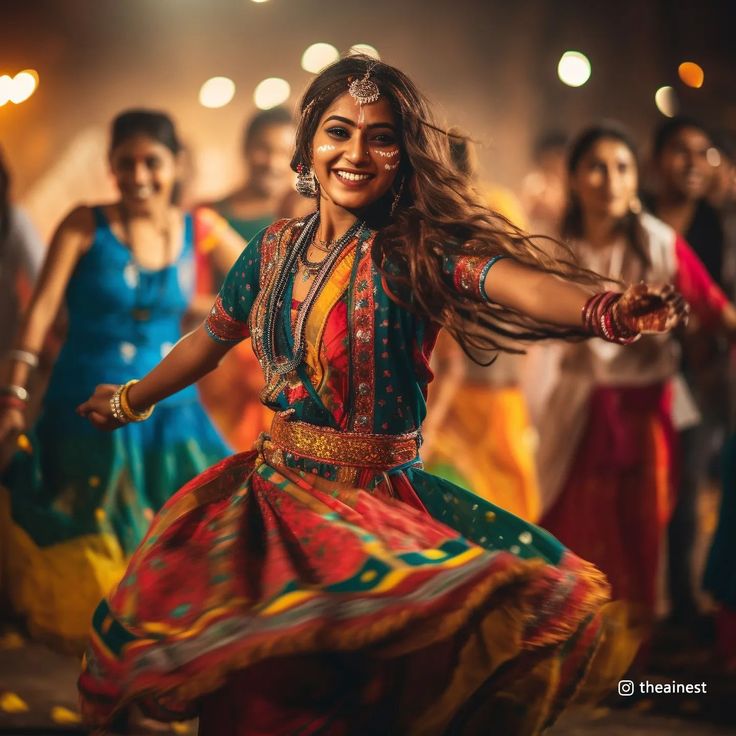
Navratri is celebrated as a vibrant and auspicious Hindu festival dedicated to the worship of the divine feminine in various forms. The word "Navratri" is derived from two Sanskrit words: "Nav" meaning nine and "Ratri" meaning nights. The festival spans nine nights and ten days and is observed twice a year – once in the spring (Chaitra Navratri) and once in the autumn (Sharad Navratri). Here are more details about why Navratri is celebrated:
Worship of Goddess Durga: The primary reason for celebrating Navratri is to honor and worship Goddess Durga, who is considered the supreme goddess and the embodiment of divine feminine energy or Shakti. The festival is dedicated to invoking the various forms of Goddess Durga known as Navadurga.
Victory of Good over Evil: Navratri commemorates the victory of Goddess Durga over the buffalo demon Mahishasura. According to Hindu mythology, Mahishasura was a powerful demon who terrorized the celestial beings. The goddess, in her various forms, fought a fierce battle for nine nights and ultimately vanquished the demon on the tenth day, which is celebrated as Vijayadashami or Dussehra.
Nine Forms of Goddess Durga (Navadurga): Each day of Navratri is dedicated to the worship of a specific form of Goddess Durga, collectively known as Navadurga. These forms include Shailaputri, Brahmacharini, Chandraghanta, Kushmanda, Skandamata, Katyayani, Kalaratri, Mahagauri, and Siddhidatri. Devotees seek the blessings of each form during the nine nights.
Symbolism of Nine Nights: The nine nights of Navratri symbolize the nine aspects of Shakti and the phases of the moon. The festival highlights the cosmic dance of creation, preservation, and destruction, represented by the goddess in her various forms.
Devotion and Spiritual Cleansing: Navratri provides an opportunity for devotees to express their devotion and seek the blessings of Goddess Durga for strength, wisdom, and protection. The festival also emphasizes spiritual purification and renewal through prayer, meditation, and self-discipline.
Cultural Celebrations: Navratri is not only a religious festival but also a cultural extravaganza. Traditional dance forms like Garba and Dandiya are popular during Navratri, especially in the western states of Gujarat and Rajasthan. These dances symbolize the joyous celebration of life and devotion to the divine.
Fasting and Penance: Many devotees observe fasts during Navratri as a form of penance and self-discipline. Fasting is believed to purify the mind and body, allowing devotees to focus on spiritual practices and connect with the divine.
Harvest Festival: In some regions, Navratri is associated with the harvest season. Farmers express gratitude for the agricultural bounty and seek the blessings of Goddess Durga for a prosperous harvest.
Unity and Community Bonding: Navratri brings communities together as families and friends participate in religious rituals, cultural events, and dance celebrations. It fosters a sense of unity, shared values, and collective devotion.
In essence, Navratri is celebrated to honor the divine feminine, seek protection and guidance from Goddess Durga, and symbolize the victory of good over evil. The festival's multi-dimensional nature, blending religious, cultural, and social elements, makes it a joyous and inclusive celebration for people across India and beyond.
It is believed that Lord Rama started this Sharadiya Navratri. Actually, Lord Rama worshiped Shakti for 9 consecutive days and then he conquered Lanka. This is the reason why Dussehra is celebrated on the tenth day after worshiping Durga Maa for nine days in the Sharadiya Navratras. Apart from this, there is another religious legend associated with it that the mahasangram of Maa Durga and Mahishasura Raksha was run for nine days. On the tenth day, Maa Durga killed Mahishasura and since then the festival started.
Traditional Celebrations

Traditional celebrations during Navratri vary across regions and communities in India, reflecting the diversity of customs and cultural practices. While there may be differences in the way Navratri is observed, certain common traditional elements are prevalent in many regions. Here are more details about traditional celebrations during Navratri:
Golu Display (South India): In South India, particularly in Tamil Nadu and Karnataka, a unique tradition known as Golu or Bommai Golu is observed during Navratri. It involves arranging and displaying dolls and figurines on steps or shelves. The display typically represents various deities, mythological scenes, and aspects of daily life. Women and children visit each other's homes to view the Golu, exchange gifts, and seek blessings.
Dandiya and Garba Dance (Gujarat and Rajasthan): In the western states of Gujarat and Rajasthan, Navratri is synonymous with vibrant and energetic dance forms like Dandiya and Garba. People gather in large groups, often in community grounds or specially erected venues, to dance in circles, twirling wooden sticks (Dandiya) or clapping hands. The dance represents the joyful celebration of life and the divine feminine.
Navratri Rangoli (Across India): The creation of colorful Rangoli designs is a common tradition during Navratri. Women and children adorn the entrances of their homes with intricate patterns made from colored powders, flowers, and rice. The Rangoli is not only a decorative element but also a symbol of auspiciousness and the welcoming of divine energy into the home.
Navadurga Puja (Across India): Devotees perform specific rituals and prayers dedicated to the nine forms of Goddess Durga, known as Navadurga. Each day of Navratri is associated with one of these forms, and devotees offer flowers, fruits, and special prayers to seek the blessings of the goddess in her various manifestations.
Kolu (Tamil Nadu): In Tamil Nadu, the tradition of Kolu involves setting up a display of dolls and figurines arranged on steps. The display often includes depictions of deities, saints, and scenes from mythology. Women and girls visit each other's homes, exchange gifts, and sing devotional songs.
Durga Puja (West Bengal): In West Bengal, Navratri culminates in the grand celebration of Durga Puja. Elaborate pandals (temporary structures) are erected to house artistic representations of Goddess Durga and her entourage. The festival involves cultural performances, processions, and the immersion of Durga idols in rivers or water bodies on the final day.
Fasting and Special Cuisine (Throughout India): Many devotees observe fasts during Navratri, abstaining from certain foods. Fasting is considered a form of penance and spiritual discipline. Special, sattvic (pure) food is prepared during this time, including dishes made from fruits, nuts, and dairy products. Some people follow specific dietary restrictions, avoiding onions, garlic, and certain grains.
Aarti and Devotional Music (Throughout India): Aarti, a ritual of waving lighted lamps before the goddess, is commonly performed during Navratri. Devotees also engage in singing devotional songs and bhajans to express their reverence and seek the divine blessings of Goddess Durga.
Community Participation (Across India): Navratri is a time when communities come together to celebrate. Community-level events, cultural programs, and processions are organized, fostering a sense of unity and shared festivity.
Vijayadashami Celebrations (After Navratri): The festival concludes with Vijayadashami or Dussehra, which marks the triumph of good over evil. Effigies of Ravana, his son Meghanada, and brother Kumbhakarna are burned in large public events, symbolizing the victory of Lord Rama over the demon king.
These traditional celebrations during Navratri not only have religious significance but also play a crucial role in fostering cultural identity, community bonding, and the celebration of the divine feminine in its various forms. The festivities bring joy, color, and a sense of spirituality to the lives of those who participate in these age-old customs.
The festival of Dussehra is celebrated to acknowledge the victory of good over evil. The celebrations of Dussehra begin from the very first day of Navratri and continue till the tenth day. A special program called “Ramlila”, which is the dramatic enactment of the great epic, Ramayana, is organized in various parts of the country. This continues for the nine days of Navratri and finally on the tenth day (Dussehra), actors dressed up as Rama and Laxman act out the final moments of the battle and shoot flaming arrows at the giant effigies of ten-headed Ravana, his brother Kumbhakarna and son Meghnad which are placed in vast open grounds (where huge crowds gather to witness this act of burning the evil).
How to Celebrate Dussehra at Home

Dussehra at home is a wonderful way to honor the triumph of good over evil and infuse your living space with festive spirit. Here are more details on how to celebrate Dussehra at home:
Pooja and Prayers: Begin the day with a special pooja (ritual worship) dedicated to Lord Rama and Goddess Durga. Clean and decorate the puja area with flowers, rangoli, and diyas. Offer fruits, flowers, and traditional sweets as offerings. Recite prayers and mantras associated with Dussehra to seek blessings.
Ravana Effigy Craft: Engage in a creative activity by making a small Ravana effigy using eco-friendly materials. This can be a fun and educational project, especially if you involve children in crafting the effigy. You can then symbolically "burn" the effigy in the evening.
Storytelling Session: Narrate or read the story of Ramayana or watch an animated version with family members. Discuss the significance of Dussehra and the values associated with Lord Rama's victory over Ravana. This helps in imparting moral and cultural lessons to the younger generation.
Cultural Performances: Organize or participate in cultural performances at home. This could include singing bhajans, playing traditional instruments, or performing folk dances. Encourage family members to showcase their talents and create a joyful atmosphere.
Festive Decorations: Decorate your home with festive elements such as torans (door hangings), rangoli, and flower arrangements. Use traditional colors such as red, yellow, and orange to create an auspicious and vibrant ambiance.
Traditional Attire: Dress in traditional attire to add to the festive spirit. Wearing ethnic clothing not only pays homage to the cultural significance of the festival but also enhances the celebratory atmosphere at home.
Special Dussehra Feast: Prepare a special feast at home with traditional dishes that are enjoyed during festivals. Include a variety of sweets and savories. Sharing a meal with family and friends is an integral part of celebrating festivals.
Gift Exchange: Exchange gifts with family members and close friends as a symbol of love and goodwill. Traditional items such as sweets, clothes, or even small idols of deities make thoughtful gifts.
Aarti and Lighting Diyas: Conduct an aarti ceremony in the evening, lighting diyas or candles. Gather family members for a collective prayer session, expressing gratitude and seeking blessings for prosperity, health, and happiness.
Ravana Effigy Burning Ritual: If feasible and safe, consider organizing a small-scale Ravana effigy burning ritual in your backyard or a designated open space. You can use a handmade effigy or purchase one from a local vendor. This symbolic act represents the victory of good over evil.
Community Engagement (Virtual or In-person): Connect with friends and extended family members through virtual platforms or, if possible, in-person gatherings. Share festive greetings, exchange stories, and participate in the collective joy of the occasion.
Charitable Acts: Consider incorporating acts of charity into your celebrations. Donate food, clothes, or other essential items to those in need. Dussehra is also a time to reflect on the importance of compassion and generosity.
Remember that the essence of celebrating Dussehra at home lies in fostering a sense of unity, joy, and gratitude. Tailor the celebrations to suit the preferences and traditions of your family, creating cherished memories and reinforcing cultural values.
The day of victory Dussehra is the 10th and final day of Navratri the Hindu festival that worships the. In India, the festival of Dussehra also known as Vijaya Dashami is celebrated every year the victory of good over evil. Dussehra ,Navratri and Diwali are celebrated on a very large scale and with just a few the first step towards preparing your house for any festival is cleaning and decorate their homes with colorful Rangoli.
Dussehra is a festival which is called the victory of good over evil. Everyone likes this festival time of the year. During this time, the brightness of the city and many such things are there, which are difficult to ignore.
The pandals of Durga Puja made in different places are challenging each other and some tasty food offerings are enough to freshen the mood of the people. If you too are wondering when Dussehra is, then this year Dussehra is being celebrated on 24th October 2023.
It is a famous Hindu festival but it is not widely celebrated like Diwali. Unfortunately, in the last few years, it has been seen that the enthusiasm of celebrating the festival has decreased.Celebration is done like a home in schools to excite the children, but watching the burning Ravana in the field with the family and watching Ramlila performed by the theater artist etc. is reduced or not at all is.
Ganesha

Ganesha, also known as Ganapati or Vinayaka, is one of the most revered and widely worshiped deities in Hinduism. Here are more details about Ganesha:
Iconography: Ganesha is easily recognizable by his distinctive appearance. He is depicted with the head of an elephant, a large potbelly, and four arms. In one hand, he holds a broken tusk, which is one of his most characteristic features. Ganesha is often shown riding a mouse, his mount or vehicle.
Lord of Beginnings and Remover of Obstacles: Ganesha is revered as the Lord of Beginnings and the Remover of Obstacles. Devotees invoke his blessings before starting any new endeavor, be it a business, journey, or educational pursuit. Ganesha is believed to pave the way for success and remove impediments from one's path.
Story of Ganesha's Birth: According to Hindu mythology, Ganesha was created by Goddess Parvati, consort of Lord Shiva. She shaped Ganesha from the sandalwood paste and breathed life into him. When Shiva returned, Ganesha, guarding his mother's privacy, denied him entry. A confrontation ensued, resulting in Shiva beheading Ganesha. In remorse, Shiva replaced Ganesha's head with that of an elephant, giving rise to his unique appearance.
Symbolism of Broken Tusk: Ganesha's broken tusk holds symbolic significance. According to one popular myth, Ganesha used his tusk to write down the epic Mahabharata as Sage Vyasa dictated it. The broken tusk symbolizes sacrifice, wisdom, and the ability to overcome obstacles.
Vahana (Mount): Ganesha's mount is a mouse, often referred to as Mushika. The mouse represents humility and the ability to gnaw through obstacles. Despite its small size, the mouse faithfully carries Ganesha.
Modak and His Love for Sweets: Ganesha is fond of modak, a sweet dumpling, and it is considered his favorite. Devotees offer modak as prasad (offering) during worship. The modak symbolizes the sweetness of the achieved goal after overcoming obstacles.
Festivals: Ganesh Chaturthi is one of the most widely celebrated festivals dedicated to Ganesha. It marks his birthday and typically involves elaborate decorations, public processions, and the immersion of Ganesha idols in water bodies. Devotees pray for blessings, wisdom, and the removal of obstacles during this festival.
Ashtavinayak Temples: The Ashtavinayak temples are a set of eight temples in the Indian state of Maharashtra, each dedicated to Ganesha. Pilgrims often undertake a spiritual journey to visit these temples, seeking the blessings of Ganesha.
Names and Forms: Ganesha is known by numerous names, each highlighting a specific aspect of his divine attributes. Some common names include Vighnaharta (remover of obstacles), Lambodara (large-bellied), Ekadanta (one-tusked), and Gajanana (elephant-faced).
Mantras and Prayers: Devotees chant various mantras and prayers dedicated to Ganesha, seeking his blessings and guidance. The most popular mantra is the "Om Gam Ganapataye Namaha," which is believed to invoke Ganesha's divine presence.
Symbol of Unity: Ganesha is often revered as a symbol of unity, as his form combines aspects of both animals and humans. This unity represents the harmony of different elements in the universe.
Global Appeal: Ganesha's worship has transcended geographical and cultural boundaries. His universal appeal extends beyond Hinduism, and people of various spiritual traditions and backgrounds invoke his blessings for success and the removal of obstacles.
In summary, Ganesha occupies a central place in Hindu worship, symbolizing auspicious beginnings, wisdom, and the ability to overcome challenges. His endearing and distinctive image, along with his compassionate nature, has endeared him to millions of devotees worldwide.
According to Hindu calendar, the festival of Ganesh Chaturthi is celebrated every year on the Chaturthi Tithi of Shukla Paksha of Bhadrapada month, which will be celebrated with great fanfare on 19 September 2023, on Tuesday, according to the English calendar this year.
The festival of Ganesh Chaturthi is celebrated all over India, but in some areas it is celebrated specially because the people of those regions celebrate this festival in the biggest festival of Hinduism.Just as the main festival of the people of West Bengal is the festival of Durga Puja or Navaratri, similarly Ganesh Chaturthi celebrates Ganesh Chaturthi as the main festival with great fanfare and gaiety.This festival of Ganesh Chaturthi lasts for about ten days, due to which it is also called Ganeshotsav.
In North India, Ganesh Chaturthi is also celebrated as the birth anniversary of Lord Shri Ganesh.It is clear from the name of Ganesh Chaturthi that in the worship of Lord Ganesha i.e. in this Ganesh festival we install the idol of Ganapati and worship him with ten days of full enthusiasm and reverence.This festival is celebrated from Chaturthi to Chaturdashi of Shukla Paksha of Bhadrapad of Hindu month.





